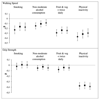Epidemiology of sarcopenia and insight into possible therapeutic targets
- PMID: 28469267
- PMCID: PMC5444517
- DOI: 10.1038/nrrheum.2017.60
Epidemiology of sarcopenia and insight into possible therapeutic targets
Abstract
Musculoskeletal ageing is a major public health concern owing to demographic shifts in the population. Sarcopenia, generally defined as the age-related loss of muscle mass and function, is associated with considerable risk of falls, loss of independence in older adults and hospitalization with poorer health outcomes. This condition is therefore associated with increased morbidity and health care costs. As with bone mass, muscle mass and strength increase during late adolescence and early adulthood, but begin to decline substantially from ∼50 years of age. Sarcopenia is characterized by many features, which include loss of muscle mass, altered muscle composition, infiltration with fat and fibrous tissue and alterations in innervation. A better understanding of these factors might help us to develop strategies that target these effects. To date, however, methodological challenges and controversies regarding how best to define the condition, in addition to uncertainty about what outcome measures to consider, have delayed research into possible therapeutic options. Most pharmacological agents investigated to date are hormonal, although new developments have seen the emergence of agents that target myostatin signalling to increase muscle mass. In this review we consider the current approaching for defining sarcopenia and discuss its epidemiology, pathogenesis, and potential therapeutic opportunities.
Conflict of interest statement
Conflict of Interest: CC has received consultancy, lecture fees and honoraria from AMGEN, GSK, Alliance for Better Bone Health, MSD, Eli Lilly, Pfizer, Novartis, Servier, Medtronic and Roche. SS and EMD declare that they have no conflict of interest.
Figures





Similar articles
-
Osteoporosis and Sarcopenia Increase Frailty Syndrome in the Elderly.Front Endocrinol (Lausanne). 2019 Apr 24;10:255. doi: 10.3389/fendo.2019.00255. eCollection 2019. Front Endocrinol (Lausanne). 2019. PMID: 31068903 Free PMC article. Review.
-
Sarcopenia-related features and factors associated with low muscle mass, weak muscle strength, and reduced function in Chinese rural residents: a cross-sectional study.Arch Osteoporos. 2018 Dec 17;14(1):2. doi: 10.1007/s11657-018-0545-2. Arch Osteoporos. 2018. PMID: 30560296
-
Dietary Patterns, Skeletal Muscle Health, and Sarcopenia in Older Adults.Nutrients. 2019 Mar 30;11(4):745. doi: 10.3390/nu11040745. Nutrients. 2019. PMID: 30935012 Free PMC article. Review.
-
Sarcopenia.Joint Bone Spine. 2019 May;86(3):309-314. doi: 10.1016/j.jbspin.2018.08.001. Epub 2018 Aug 8. Joint Bone Spine. 2019. PMID: 30098424 Review.
-
Leisure-time physical activity at moderate and high intensity is associated with parameters of body composition, muscle strength and sarcopenia in aged adults with obesity and metabolic syndrome from the PREDIMED-Plus study.Clin Nutr. 2019 Jun;38(3):1324-1331. doi: 10.1016/j.clnu.2018.05.023. Epub 2018 Jun 6. Clin Nutr. 2019. PMID: 29910068
Cited by
-
Unveiling the Intricate Dance: How Cancer Orchestrates Muscle Wasting and Sarcopenia.In Vivo. 2024 Jul-Aug;38(4):1520-1529. doi: 10.21873/invivo.13602. In Vivo. 2024. PMID: 38936901 Free PMC article. Review.
-
Lumican, an Exerkine, Protects against Skeletal Muscle Loss.Int J Mol Sci. 2022 Sep 2;23(17):10031. doi: 10.3390/ijms231710031. Int J Mol Sci. 2022. PMID: 36077426 Free PMC article.
-
Brachial-Ankle Pulse Wave Velocity Mediates the Association between Increased Age and Risk of Sarcopenia among Chinese Patients with Type 2 Diabetes Mellitus.J Diabetes Res. 2023 Jan 6;2023:3786342. doi: 10.1155/2023/3786342. eCollection 2023. J Diabetes Res. 2023. PMID: 36643790 Free PMC article.
-
High Intensity Interval Training: A Potential Method for Treating Sarcopenia.Clin Interv Aging. 2022 May 26;17:857-872. doi: 10.2147/CIA.S366245. eCollection 2022. Clin Interv Aging. 2022. PMID: 35656091 Free PMC article. Review.
-
Frailty, sarcopenia and health related outcomes among elderly patients in Saudi Arabia.Saudi J Biol Sci. 2021 Feb;28(2):1213-1217. doi: 10.1016/j.sjbs.2020.11.058. Epub 2020 Nov 24. Saudi J Biol Sci. 2021. PMID: 33613049 Free PMC article.
References
-
- Cruz-Jentoft AJ, Landi F, Schneider SM, Zuniga C, Arai H, Boirie Y, Chen L-K, Fielding RA, Martin FC, Michel J-P, Sieber C, et al. Prevalence of and interventions for sarcopenia in ageing adults: a systematic review. Report of the International Sarcopenia Initiative (EWGSOP and IWGS) Age Ageing. 2014;43:748–759. doi: 10.1093/ageing/afu115. - DOI - PMC - PubMed
-
- Muscaritoli M, Anker SD, Argilés J, Aversa Z, Bauer JM, Biolo G, Boirie Y, Bosaeus I, Cederholm T, Costelli P, Fearon KC, et al. Consensus definition of sarcopenia, cachexia and pre-cachexia: Joint document elaborated by Special Interest Groups (SIG) “ cachexia-anorexia in chronic wasting diseases” and “ nutrition in geriatrics”. Clin Nutr. 2010;29:154–159. doi: 10.1016/j.clnu.2009.12.004. - DOI - PubMed
-
- Cruz-Jentoft AJ, Baeyens JP, Bauer JM, Boirie Y, Cederholm T, Landi F, Martin FC, Michel J-P, Rolland Y, Schneider SM, Topinkova E, et al. Sarcopenia: European consensus on definition and diagnosis: Report of the European Working Group on Sarcopenia in Older People. Age Ageing. 2010;39:412–423. doi: 10.1093/ageing/afq034. - DOI - PMC - PubMed
Publication types
MeSH terms
Grants and funding
- 19583/ARC_/Arthritis Research UK/United Kingdom
- MC_UP_A620_1015/MRC_/Medical Research Council/United Kingdom
- MC_U147574237/MRC_/Medical Research Council/United Kingdom
- MC_U147574234/MRC_/Medical Research Council/United Kingdom
- MC_UU_12011/2/MRC_/Medical Research Council/United Kingdom
- MC_U147585819/MRC_/Medical Research Council/United Kingdom
- MC_UP_A620_1014/MRC_/Medical Research Council/United Kingdom
- 19583/VAC_/Versus Arthritis/United Kingdom
- MC_UU_12011/1/MRC_/Medical Research Council/United Kingdom
- G0400491/MRC_/Medical Research Council/United Kingdom
- MC_U147585824/MRC_/Medical Research Council/United Kingdom
- MC_U147585827/MRC_/Medical Research Council/United Kingdom
- MC_U147574212/MRC_/Medical Research Council/United Kingdom
LinkOut - more resources
Full Text Sources
Other Literature Sources
Research Materials

